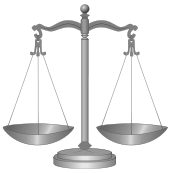- American Bar Association Model Rules of Professional Conduct
-

Professional responsibility Duties to the client Confidentiality
Avoiding conflict of interest
Diligence and competence
Avoid commingling
Avoid self-dealing
Effective assistance
Avoid fee splitting
Withdrawal from representationDuties to the court Disclosure of perjury
Disclosure of adverse authorityDuties to the profession Limitations on legal advertising
Report misconductSources of law ABA Model Rules Penalties for misconduct Disbarment · Judicial misconduct The ABA Model Rules of Professional Conduct, created by the American Bar Association (ABA), are a set of rules that prescribe baseline standards of legal ethics and professional responsibility for lawyers in the United States. They were promulgated by the ABA House of Delegates upon the recommendation of the Kutak Commission in 1983. The rules are merely recommendations, or models, (hence the name "Model Rules") and are not themselves binding. However, having a common set of Model Rules facilitates a common discourse on legal ethics, and simplifies professional responsibility training as well as the day-to-day application of such rules. As of 2009, 49 U.S. states have adopted the rules in whole or in part, of which the most recent to do so was Maine.
Contents
State adoptions of the Rules
The ABA is a voluntary bar association without lawmaking power (meaning that it is just like any other nongovernmental professional association). Accordingly, the Model Rules are not legally binding in and of themselves. However, they have been adopted, in whole or in part, as the professional standards of conduct by the judiciaries or integrated bar associations of 49 U.S. states. Rules adopted in a particular state (that may be based upon the Model Rules) are legally enforceable against the lawyers of that state as well as any lawyer practicing there temporarily on a pro hac vice basis.
On December 17, 2008, New York announced that it would finally abandon the old Model Code (it was the last state to do so) and adopt a heavily modified version of the Model Rules, effective April 1, 2009.[1] In June 2009, the Supreme Court of Maine approved the adoption of the Model Rules in that state, effective August 1, 2009.[2]
California has its own set of unique professional responsibility rules. California rules differ significantly from the ABA rules in structure and content. Besides the obvious transactional costs incurred in retraining thousands of attorneys (there are over 210,000 attorneys in California), another reason for not adopting the ABA rules is that they conflict with the fundamental public policy of the state.
For example, the State Bar of California and the California State Legislature have long taken the position that clients must be encouraged to speak candidly to their counsel about both past and future actions knowing their statements will be held in complete confidence. Then their counsel can explain the relevant law to them and urge them to conform their future conduct to the law, thus promoting lawful conduct. In contrast, Model Rule 1.6 contains exceptions to confidentiality for both violent and nonviolent (e.g. financial) future crimes, which in turn creates a strong disincentive for clients to discuss their plans with their lawyers. In turn, clients may end up proceeding in total ignorance of the relevant law (and violate it as a result).
Another notable difference is that Model Rule 1.8(j) contains an outright ban on sexual relations between lawyer and client (unless the relationship predated the legal representation), while California Rule 3-120 only prohibits sex under certain circumstances, such as where coercion or prostitution is involved or when it causes the attorney "to perform legal services incompetently."
Since 2001, the Commission for the Revision of the Rules of Professional Conduct of the State Bar of California has been attempting a comprehensive revision of the California rules that would, among other things, convert them into a localized version of the Model Rules. However, the Commission's progress has been extremely slow, simply because there are so many substantive and structural differences between the California rules and the Model Rules.
Self-governing body
Generally, the legal profession in the United States is a self-regulating and self-policing organization. Lawyers control the regulatory institutions that control lawyers, and such institutions are subject to supervision by the judiciary, which itself consists of lawyers who became judges. In contrast, many other professions, such as medicine, are controlled by executive branch disciplinary bodies that have many members who come from outside such professions, and who may have been appointed by the governor of the state, who is not necessarily a member of those professions.
The concept of the self-regulating profession has repeatedly been attacked as ineffective in controlling unethical or incompetent lawyers, especially after the Watergate scandal. The Model Rules were specifically formulated by the ABA's Kutak Commission after Watergate to demonstrate that the American legal profession was capable of regulating itself and to alleviate demands that lawyer regulation be centralized into federal or state agencies directly accountable to the public.
References
- ^ Press Release: New Attorney Rules of Professional Conduct Announced, Communications Office of the New York Courts, 17 December 2008.
- ^ http://www.courts.state.me.us/rules_forms_fees/rules/MRProfCond6-4-09.pdf Broken link
See also
External links
Categories:- 1983 in law
- Legal ethics
- Codes of conduct
- American Bar Association
- United States law
Wikimedia Foundation. 2010.
